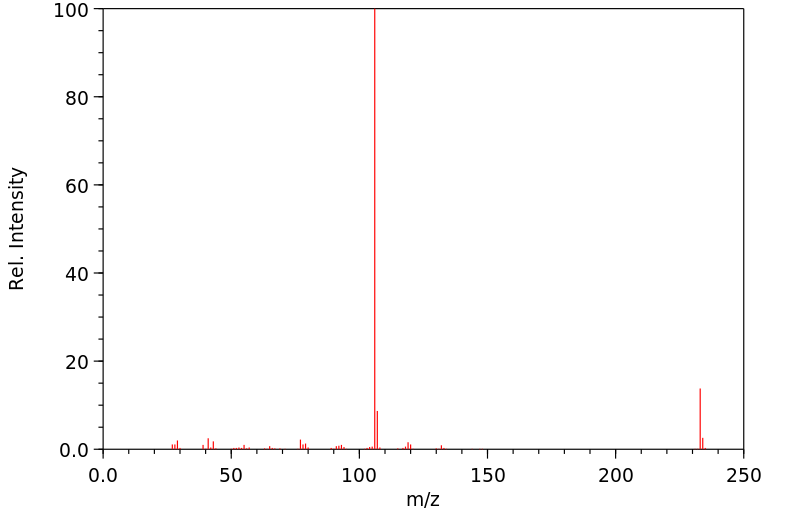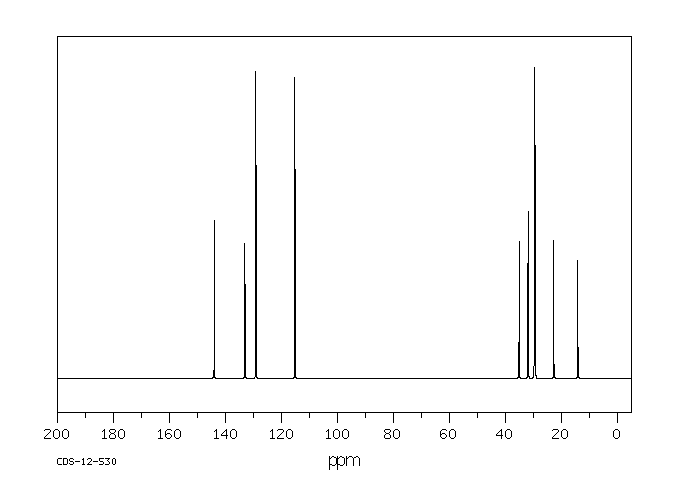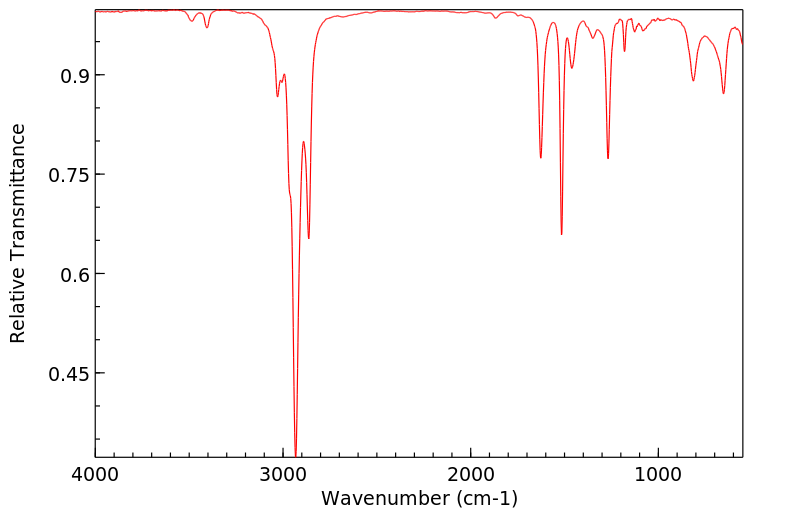4-癸基苯胺 | 37529-30-9
中文名称
4-癸基苯胺
中文别名
4-正癸基苯胺
英文名称
4-n-decylaniline
英文别名
4-Decylaniline;p-decylaniline;4-decylbenzenamine
CAS
37529-30-9
化学式
C16H27N
mdl
MFCD00007918
分子量
233.397
InChiKey
WGENWPANMZLPIH-UHFFFAOYSA-N
BEILSTEIN
——
EINECS
——
-
物化性质
-
计算性质
-
ADMET
-
安全信息
-
SDS
-
制备方法与用途
-
上下游信息
-
文献信息
-
表征谱图
-
同类化合物
-
相关功能分类
-
相关结构分类
物化性质
-
熔点:25 °C (lit.)
-
沸点:218-220 °C/14 mmHg (lit.)
-
密度:0.8952 (estimate)
-
闪点:>230 °F
-
稳定性/保质期:
常规情况下不会分解,也没有危险反应。
计算性质
-
辛醇/水分配系数(LogP):6.1
-
重原子数:17
-
可旋转键数:9
-
环数:1.0
-
sp3杂化的碳原子比例:0.625
-
拓扑面积:26
-
氢给体数:1
-
氢受体数:1
安全信息
-
危险品标志:Xi
-
安全说明:S26,S37/39
-
危险类别码:R36/37/38
-
WGK Germany:3
-
海关编码:2921420090
-
储存条件:密封、阴凉、干燥保存。
SDS
Section 1. IDENTIFICATION OF THE SUBSTANCE/MIXTURE
Product identifiers
Product name : 4-Decylaniline
CAS-No. : 37529-30-9
Relevant identified uses of the substance or mixture and uses advised against
Identified uses : Laboratory chemicals, Manufacture of substances
Section 2. HAZARDS IDENTIFICATION
Classification of the substance or mixture
Classification according to Regulation (EC) No 1272/2008 [EU-GHS/CLP]
Skin irritation (Category 2)
Eye irritation (Category 2)
Specific target organ toxicity - single exposure (Category 3)
Acute aquatic toxicity (Category 1)
Classification according to EU Directives 67/548/EEC or 1999/45/EC
Irritating to eyes, respiratory system and skin.
Label elements
Labelling according Regulation (EC) No 1272/2008 [CLP]
Pictogram
Signal word Warning
Hazard statement(s)
H315 Causes skin irritation.
H319 Causes serious eye irritation.
H335 May cause respiratory irritation.
H400 Very toxic to aquatic life.
Precautionary statement(s)
P261 Avoid breathing dust/ fume/ gas/ mist/ vapours/ spray.
P273 Avoid release to the environment.
P305 + P351 + P338 IF IN EYES: Rinse cautiously with water for several minutes. Remove
contact lenses, if present and easy to do. Continue rinsing.
Supplemental Hazard none
Statements
According to European Directive 67/548/EEC as amended.
Hazard symbol(s)
R-phrase(s)
R36/37/38 Irritating to eyes, respiratory system and skin.
S-phrase(s)
S26 In case of contact with eyes, rinse immediately with plenty of water and
seek medical advice.
S37/39 Wear suitable gloves and eye/face protection.
Other hazards - none
Section 3. COMPOSITION/INFORMATION ON INGREDIENTS
Substances
Formula : C16H27N
Molecular Weight : 233,39 g/mol
Component Concentration
4-Decylaniline
CAS-No. 37529-30-9 -
EC-No. 253-546-9
Section 4. FIRST AID MEASURES
Description of first aid measures
General advice
Consult a physician. Show this safety data sheet to the doctor in attendance.
If inhaled
If breathed in, move person into fresh air. If not breathing, give artificial respiration. Consult a physician.
In case of skin contact
Wash off with soap and plenty of water. Consult a physician.
In case of eye contact
Rinse thoroughly with plenty of water for at least 15 minutes and consult a physician.
If swallowed
Never give anything by mouth to an unconscious person. Rinse mouth with water. Consult a physician.
Most important symptoms and effects, both acute and delayed
To the best of our knowledge, the chemical, physical, and toxicological properties have not been
thoroughly investigated.
Indication of any immediate medical attention and special treatment needed
no data available
Section 5. FIREFIGHTING MEASURES
Extinguishing media
Suitable extinguishing media
Use water spray, alcohol-resistant foam, dry chemical or carbon dioxide.
Special hazards arising from the substance or mixture
Carbon oxides, nitrogen oxides (NOx)
Advice for firefighters
Wear self contained breathing apparatus for fire fighting if necessary.
Further information
no data available
Section 6. ACCIDENTAL RELEASE MEASURES
Personal precautions, protective equipment and emergency procedures
Use personal protective equipment. Avoid breathing vapors, mist or gas. Ensure adequate ventilation.
Evacuate personnel to safe areas.
Environmental precautions
Prevent further leakage or spillage if safe to do so. Do not let product enter drains. Discharge into the
environment must be avoided.
Methods and materials for containment and cleaning up
Soak up with inert absorbent material and dispose of as hazardous waste. Keep in suitable, closed
containers for disposal.
Reference to other sections
For disposal see section 13.
Section 7. HANDLING AND STORAGE
Precautions for safe handling
Avoid contact with skin and eyes. Avoid inhalation of vapour or mist.
Normal measures for preventive fire protection.
Conditions for safe storage, including any incompatibilities
Store in cool place. Keep container tightly closed in a dry and well-ventilated place. Containers which are
opened must be carefully resealed and kept upright to prevent leakage.
Specific end use(s)
no data available
Section 8. EXPOSURE CONTROLS/PERSONAL PROTECTION
Control parameters
Components with workplace control parameters
Exposure controls
Appropriate engineering controls
Handle in accordance with good industrial hygiene and safety practice. Wash hands before breaks and
at the end of workday.
Personal protective equipment
Eye/face protection
Safety glasses with side-shields conforming to EN166 Use equipment for eye protection tested
and approved under appropriate government standards such as NIOSH (US) or EN 166(EU).
Skin protection
Handle with gloves. Gloves must be inspected prior to use. Use proper glove removal technique
(without touching glove's outer surface) to avoid skin contact with this product. Dispose of
contaminated gloves after use in accordance with applicable laws and good laboratory practices.
Wash and dry hands.
The selected protective gloves have to satisfy the specifications of EU Directive 89/686/EEC and
the standard EN 374 derived from it.
Body Protection
impervious clothing, The type of protective equipment must be selected according to the
concentration and amount of the dangerous substance at the specific workplace.
Respiratory protection
Where risk assessment shows air-purifying respirators are appropriate use a full-face respirator
with multi-purpose combination (US) or type ABEK (EN 14387) respirator cartridges as a backup
to engineering controls. If the respirator is the sole means of protection, use a full-face supplied air
respirator. Use respirators and components tested and approved under appropriate government
standards such as NIOSH (US) or CEN (EU).
Section 9. PHYSICAL AND CHEMICAL PROPERTIES
Information on basic physical and chemical properties
a) Appearance Form: liquid
Colour: light orange
b) Odour no data available
c) Odour Threshold no data available
d) pH no data available
e) Melting point/freezing Melting point/range: 25 °C - lit.
point
f) Initial boiling point and 218 - 220 °C at 19 hPa - lit.
boiling range
g) Flash point 113 °C - closed cup
h) Evaporation rate no data available
i) Flammability (solid, gas) no data available
j) Upper/lower no data available
flammability or
explosive limits
k) Vapour pressure no data available
l) Vapour density no data available
m) Relative density no data available
n) Water solubility no data available
o) Partition coefficient: n- no data available
octanol/water
p) Auto-ignition no data available
temperature
q) Decomposition no data available
temperature
r) Viscosity no data available
s) Explosive properties no data available
t) Oxidizing properties no data available
Other safety information
no data available
Section 10. STABILITY AND REACTIVITY
Reactivity
no data available
Chemical stability
no data available
Possibility of hazardous reactions
no data available
Conditions to avoid
no data available
Incompatible materials
Strong oxidizing agents, Strong acids, Acid chlorides, Acid anhydrides
Hazardous decomposition products
Other decomposition products - no data available
Section 11. TOXICOLOGICAL INFORMATION
Information on toxicological effects
Acute toxicity
no data available
Skin corrosion/irritation
no data available
Serious eye damage/eye irritation
no data available
Respiratory or skin sensitization
no data available
Germ cell mutagenicity
no data available
Carcinogenicity
IARC: No component of this product present at levels greater than or equal to 0.1% is identified as
probable, possible or confirmed human carcinogen by IARC.
Reproductive toxicity
no data available
Specific target organ toxicity - single exposure
Inhalation - May cause respiratory irritation.
Specific target organ toxicity - repeated exposure
no data available
Aspiration hazard
no data available
Potential health effects
Inhalation May be harmful if inhaled. Causes respiratory tract irritation.
Ingestion May be harmful if swallowed.
Skin May be harmful if absorbed through skin. Causes skin irritation.
Eyes Causes serious eye irritation.
Signs and Symptoms of Exposure
To the best of our knowledge, the chemical, physical, and toxicological properties have not been
thoroughly investigated.
Additional Information
RTECS: Not available
Section 12. ECOLOGICAL INFORMATION
Toxicity
Toxicity to fish LC50 - Pimephales promelas (fathead minnow) - 0,063 mg/l - 96 h
Toxicity to daphnia and EC50 - Daphnia magna (Water flea) - 0,0084 mg/l - 48 h
other aquatic
invertebrates
Persistence and degradability
no data available
Bioaccumulative potential
no data available
Mobility in soil
no data available
Results of PBT and vPvB assessment
no data available
Other adverse effects
Very toxic to aquatic life.
no data available
Section 13. DISPOSAL CONSIDERATIONS
Waste treatment methods
Product
Offer surplus and non-recyclable solutions to a licensed disposal company. Contact a licensed
professional waste disposal service to dispose of this material.
Contaminated packaging
Dispose of as unused product.
Section 14. TRANSPORT INFORMATION
UN number
ADR/RID: 3082 IMDG: 3082 IATA: 3082
UN proper shipping name
ADR/RID: ENVIRONMENTALLY HAZARDOUS SUBSTANCE, LIQUID, N.O.S. (4-Decylaniline)
IMDG: ENVIRONMENTALLY HAZARDOUS SUBSTANCE, LIQUID, N.O.S. (4-Decylaniline)
IATA: Environmentally hazardous substance, liquid, n.o.s. (4-Decylaniline)
Transport hazard class(es)
ADR/RID: 9 IMDG: 9 IATA: 9
Packaging group
ADR/RID: III IMDG: III IATA: III
Environmental hazards
ADR/RID: yes IMDG Marine Pollutant: yes IATA: yes
Special precautions for user
Further information
EHS-Mark required (ADR 2.2.9.1.10, IMDG code 2.10.3) for single packagings and combination
packagings containing inner packagings with Dangerous Goods > 5L for liquids or > 5kg for solids.
Section 15. REGULATORY INFORMATION
This safety datasheet complies with the requirements of Regulation (EC) No. 1907/2006.
Safety, health and environmental regulations/legislation specific for the substance or mixture
no data available
Chemical Safety Assessment
no data available
Section 16. OTHER INFORMATION
Further information
Copyright 2012 Co. LLC. License granted to make unlimited paper copies for internal use
only.
The above information is believed to be correct but does not purport to be all inclusive and shall be
used only as a guide. The information in this document is based on the present state of our knowledge
and is applicable to the product with regard to appropriate safety precautions. It does not represent any
guarantee of the properties of the product. Corporation and its Affiliates shall not be held
liable for any damage resulting from handling or from contact with the above product. See
and/or the reverse side of invoice or packing slip for additional terms and conditions of sale.
上下游信息
-
上游原料
中文名称 英文名称 CAS号 化学式 分子量 癸基苯 decylbenzene 104-72-3 C16H26 218.382 —— 4'-aminodecanoylphenone 101449-24-5 C16H25NO 247.381 -
下游产品
中文名称 英文名称 CAS号 化学式 分子量 —— bis(4-decylphenyl)diazene 37593-00-3 C32H50N2 462.762 4-溴正癸基苯 1-bromo-4-decylbenzene 106418-67-1 C16H25Br 297.279 —— terephthalylidene-bis-<4-n-decyl-aniline> 65726-57-0 C40H56N2 564.898 —— 1-Buta-1,3-diynyl-4-decylbenzene 1026608-05-8 C20H26 266.426
反应信息
-
作为反应物:描述:4-癸基苯胺 在 盐酸 、 calcium carbonate 、 benzyl triethylammonium dichloroiodate 、 sodium nitrite 作用下, 以 四氢呋喃 、 甲醇 、 乙醚 、 二氯甲烷 、 乙腈 为溶剂, 反应 4.0h, 生成 N,N-Diethyl-N'-(4-decyl-2-iodophenyl)triazene参考文献:名称:膨胀石墨二炔亚结构的合成摘要:Graphdiyne(1)是一个有趣且潜在重要的碳同素异形体新家族的成员。本文报道的是模型子结构2-6的合成和光谱表征。大环通过合适的α,ω-聚炔的分子内环化制备。该方法成功的关键是利用反应性苯基丁二炔合成子进行原位丙二甲硅烷基化/炔基化反应。迄今为止,这种新方法可以制备石墨二炔网络中最大,最完整的子结构(3-6)。DOI:10.1002/1521-3765(20000602)6:11<2044::aid-chem2044>3.0.co;2-y
-
作为产物:参考文献:名称:Liquid-Crystalline Polymorphism of Symmetrical Azobananas: bis(4-(4-alkylphenyl)azophenyl) 2-nitroisophtalates摘要:In this paper we present a series of novel compounds, bis(4-(4-alkylphenyl)azophenyl) 2-nitroisophtalates, which exhibit nematic and banana-type liquid-crystalline phases. The alkyl chain length varies from 1 to 18 carbons. The first ten members of this series exhibit nematic phase. The last eleven compounds exhibit banana-type liquid crystalline phases. The propyl and pentyl derivatives have extra second type of banana mesophase.DOI:10.1080/15421400903065754
文献信息
-
Process for preparing 1,2,4-benzotriazine oxides申请人:S R I International公开号:US05175287A1公开(公告)日:1992-12-29A method of using 1,2,4-benzotriazine oxides, some of which are novel compounds, as radiosensitizers and selective cytotoxic agents is disclosed. These compounds are shown to specifically radiosensitize hypoxic tumor cells. Some are additionally disclosed to be useful as specific cytotoxic agents for these cells. They also show an unexpected ability to radiosensitize aerobic cells following or preceding a hypoxic incubation of the cells with the drug. This provides a basis for selective radiosensitization of tumors compared to normal cells. A novel method for preparing the 1,2,4-benzotriazine oxides is also disclosed.
-
Antimitotic Antitumor Agents: Synthesis, Structure−Activity Relationships, and Biological Characterization of <i>N</i>-Aryl-<i>N</i>‘-(2-chloroethyl)ureas as New Selective Alkylating Agents作者:Emmanuelle Mounetou、Jean Legault、Jacques Lacroix、René C-GaudreaultDOI:10.1021/jm0010264日期:2001.3.1series of N-aryl-N'-(2-chloroethyl)ureas (CEUs) and derivatives were synthesized and evaluated for antiproliferative activity against a wide panel of tumor cell lines. Systematic structure--activity relationship (SAR) studies indicated that: (i) a branched alkyl chain or a halogen at the 4-position of the phenyl ring or a fluorenyl/indanyl group, (ii) an exocyclic urea function, and (iii) a N'-2-chloroethyl合成了一系列的N-芳基-N'-(2-氯乙基)脲(CEU)及其衍生物,并评估了其对多种肿瘤细胞系的抗增殖活性。系统结构-活性关系(SAR)研究表明:(i)苯环或芴基/茚满基4位上的支链烷基链或卤素,(ii)外环脲官能团,和(iii) )需要N'-2-氯乙基部分以确保明显的细胞毒性。诸如免疫荧光显微镜等生物学实验证实,这些有前途的化合物通过β-微管蛋白的选择性烷基化诱导微管解聚,从而改变了细胞骨架。随后的评估表明,有效的CEU是弱烷基化剂,是非DNA破坏剂,并且不与谷胱甘肽或谷胱甘肽还原酶的硫醇功能相互作用。因此,CEU是新型抗有丝分裂剂的一部分。最后,在评估的一系列CEU中,选择了化合物12、15、16和27用于进一步的体内试验。
-
Synthesis of Functionalized Diaryldiazenes by Formal [3+3] Cyclizations of 1,3-Bis(silyloxy)-1,3-butadienes with 2-Aryldiazenyl-3-silyloxy-2-en-1- ones作者:Jennifer Hefner、Simone Ladzik、Martin Hein、Manuela Harms、Michael Lalk、Nazken Kelzhanova、Amanzhan T. Saginayev、Qamar Rahman、Alexander Villinger、Christine Fischer、Peter LangerDOI:10.5560/znb.2014-3198日期:2014.8.1
The formal [3+3] cyclization of 1,3-bis(silyloxy)-1,3-butadienes with 2-aryldiazenyl-3-silyloxy- 2-en-1-ones afforded a variety of functionalized diaryl-diazenes.
-
Method of treating a mammal having a solid tumor susceptible to申请人:The Board of Trustees of the Leland Stanford Junior University公开号:US05484612A1公开(公告)日:1996-01-16A method of treating a mammal having a solid tumor susceptible to treatment with cisplatin comprising: administering to the mammal an effective amount of 3-amino-1,2,4-benzotriazine 1,4-dioxide; and administering to the mammal an effective amount of cisplatin about 0.5 to about five hours after administration of the 3-amino-1,2,4-benzotriazine 1,4-dioxide.
-
由桥接二噻唑共聚物制备的半导体材料申请人:巴斯夫欧洲公司公开号:CN103052643B公开(公告)日:2016-03-09本发明提供了式 的半导体化合物、低聚物和聚合物,其中A 1 和A 2 可以相同或不同且为S或Se,E选自 。式(1)的化合物、低聚物和聚合物适合用于电子器件如有机场效应晶体管中。
表征谱图
-
氢谱1HNMR
-
质谱MS
-
碳谱13CNMR
-
红外IR
-
拉曼Raman
-
峰位数据
-
峰位匹配
-
表征信息
同类化合物
(βS)-β-氨基-4-(4-羟基苯氧基)-3,5-二碘苯甲丙醇
(S,S)-邻甲苯基-DIPAMP
(S)-(-)-7'-〔4(S)-(苄基)恶唑-2-基]-7-二(3,5-二-叔丁基苯基)膦基-2,2',3,3'-四氢-1,1-螺二氢茚
(S)-盐酸沙丁胺醇
(S)-3-(叔丁基)-4-(2,6-二甲氧基苯基)-2,3-二氢苯并[d][1,3]氧磷杂环戊二烯
(S)-2,2'-双[双(3,5-三氟甲基苯基)膦基]-4,4',6,6'-四甲氧基联苯
(S)-1-[3,5-双(三氟甲基)苯基]-3-[1-(二甲基氨基)-3-甲基丁烷-2-基]硫脲
(R)富马酸托特罗定
(R)-(-)-盐酸尼古地平
(R)-(-)-4,12-双(二苯基膦基)[2.2]对环芳烷(1,5环辛二烯)铑(I)四氟硼酸盐
(R)-(+)-7-双(3,5-二叔丁基苯基)膦基7''-[((6-甲基吡啶-2-基甲基)氨基]-2,2'',3,3''-四氢-1,1''-螺双茚满
(R)-(+)-7-双(3,5-二叔丁基苯基)膦基7''-[(4-叔丁基吡啶-2-基甲基)氨基]-2,2'',3,3''-四氢-1,1''-螺双茚满
(R)-(+)-7-双(3,5-二叔丁基苯基)膦基7''-[(3-甲基吡啶-2-基甲基)氨基]-2,2'',3,3''-四氢-1,1''-螺双茚满
(R)-(+)-4,7-双(3,5-二-叔丁基苯基)膦基-7“-[(吡啶-2-基甲基)氨基]-2,2”,3,3'-四氢1,1'-螺二茚满
(R)-3-(叔丁基)-4-(2,6-二苯氧基苯基)-2,3-二氢苯并[d][1,3]氧杂磷杂环戊烯
(R)-2-[((二苯基膦基)甲基]吡咯烷
(R)-1-[3,5-双(三氟甲基)苯基]-3-[1-(二甲基氨基)-3-甲基丁烷-2-基]硫脲
(N-(4-甲氧基苯基)-N-甲基-3-(1-哌啶基)丙-2-烯酰胺)
(5-溴-2-羟基苯基)-4-氯苯甲酮
(5-溴-2-氯苯基)(4-羟基苯基)甲酮
(5-氧代-3-苯基-2,5-二氢-1,2,3,4-oxatriazol-3-鎓)
(4S,5R)-4-甲基-5-苯基-1,2,3-氧代噻唑烷-2,2-二氧化物-3-羧酸叔丁酯
(4S,4''S)-2,2''-亚环戊基双[4,5-二氢-4-(苯甲基)恶唑]
(4-溴苯基)-[2-氟-4-[6-[甲基(丙-2-烯基)氨基]己氧基]苯基]甲酮
(4-丁氧基苯甲基)三苯基溴化磷
(3aR,8aR)-(-)-4,4,8,8-四(3,5-二甲基苯基)四氢-2,2-二甲基-6-苯基-1,3-二氧戊环[4,5-e]二恶唑磷
(3aR,6aS)-5-氧代六氢环戊基[c]吡咯-2(1H)-羧酸酯
(2Z)-3-[[(4-氯苯基)氨基]-2-氰基丙烯酸乙酯
(2S,3S,5S)-5-(叔丁氧基甲酰氨基)-2-(N-5-噻唑基-甲氧羰基)氨基-1,6-二苯基-3-羟基己烷
(2S,2''S,3S,3''S)-3,3''-二叔丁基-4,4''-双(2,6-二甲氧基苯基)-2,2'',3,3''-四氢-2,2''-联苯并[d][1,3]氧杂磷杂戊环
(2S)-(-)-2-{[[[[3,5-双(氟代甲基)苯基]氨基]硫代甲基]氨基}-N-(二苯基甲基)-N,3,3-三甲基丁酰胺
(2S)-2-[[[[[((1S,2S)-2-氨基环己基]氨基]硫代甲基]氨基]-N-(二苯甲基)-N,3,3-三甲基丁酰胺
(2S)-2-[[[[[[((1R,2R)-2-氨基环己基]氨基]硫代甲基]氨基]-N-(二苯甲基)-N,3,3-三甲基丁酰胺
(2-硝基苯基)磷酸三酰胺
(2,6-二氯苯基)乙酰氯
(2,3-二甲氧基-5-甲基苯基)硼酸
(1S,2S,3S,5S)-5-叠氮基-3-(苯基甲氧基)-2-[(苯基甲氧基)甲基]环戊醇
(1S,2S,3R,5R)-2-(苄氧基)甲基-6-氧杂双环[3.1.0]己-3-醇
(1-(4-氟苯基)环丙基)甲胺盐酸盐
(1-(3-溴苯基)环丁基)甲胺盐酸盐
(1-(2-氯苯基)环丁基)甲胺盐酸盐
(1-(2-氟苯基)环丙基)甲胺盐酸盐
(1-(2,6-二氟苯基)环丙基)甲胺盐酸盐
(-)-去甲基西布曲明
龙蒿油
龙胆酸钠
龙胆酸叔丁酯
龙胆酸
龙胆紫-d6
龙胆紫










